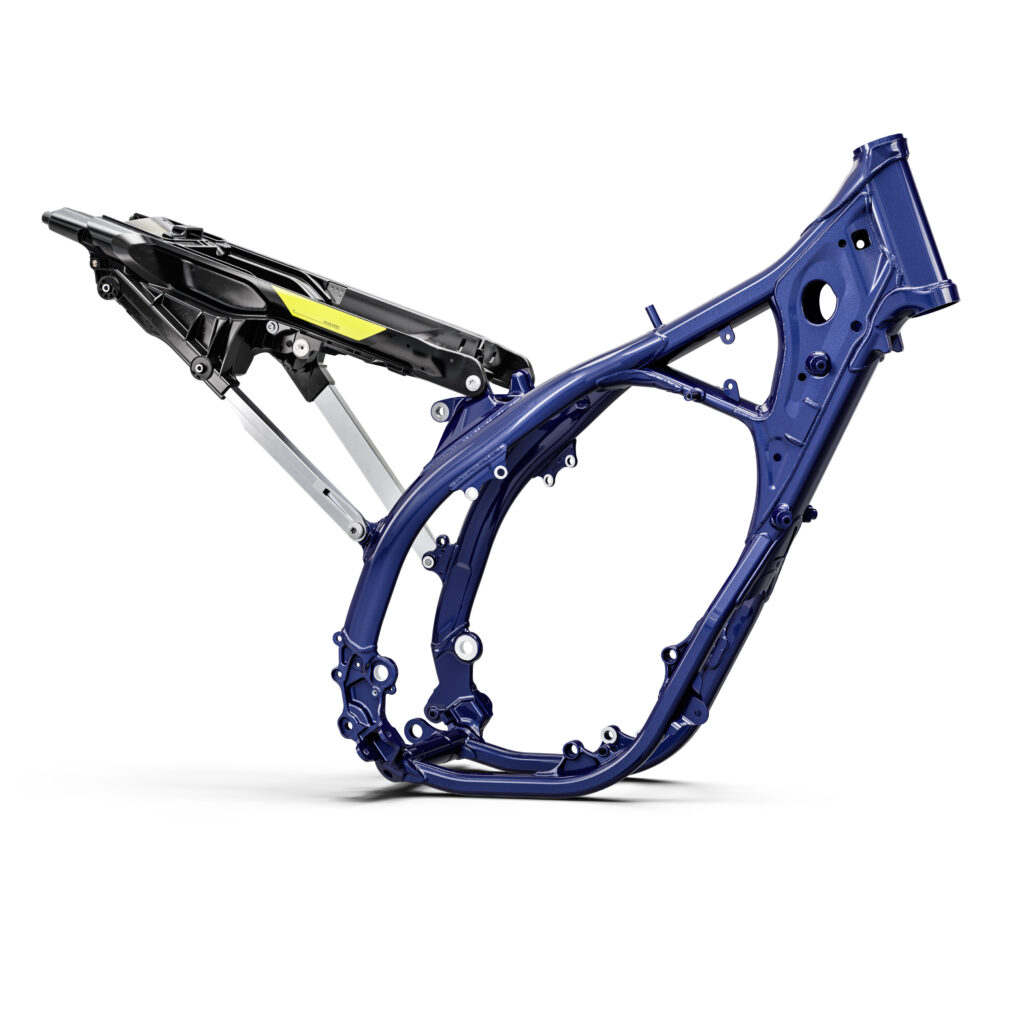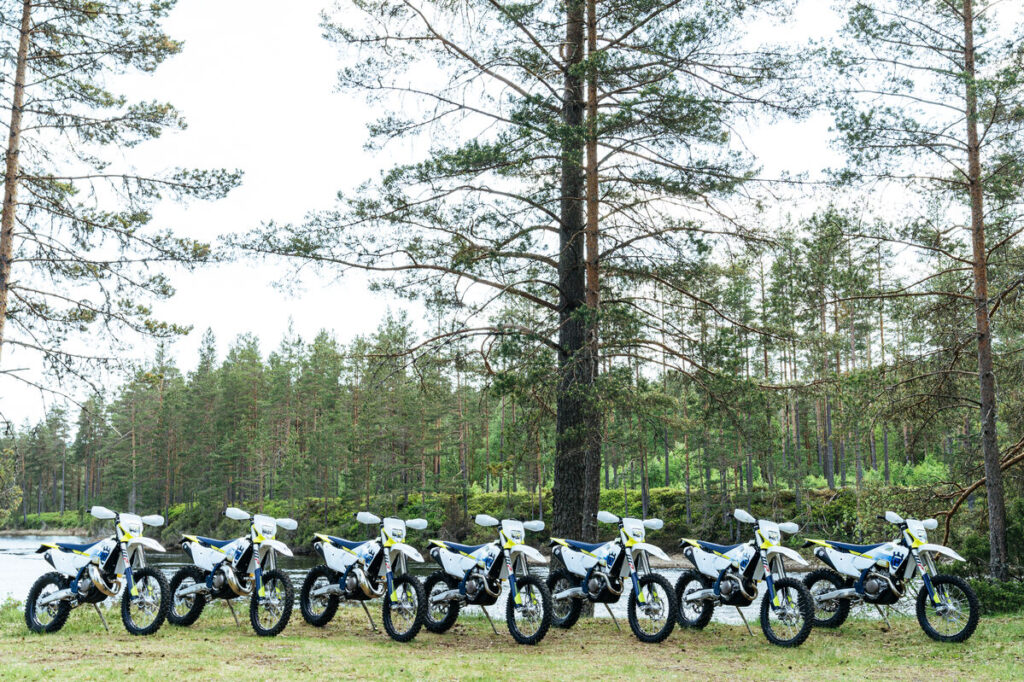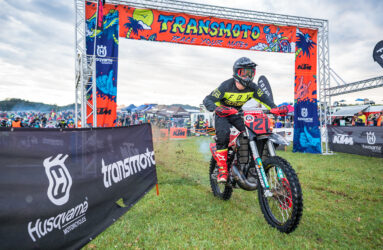2024 HUSKY ENDURO RANGE: DESIGN PROCESS EXPLAINED
What’s involved in taking a new-generation range of Husqvarna motorcycles from conception to production line? How long does that process take? Does inspiration come from competitors? What does Husky’s design team mean when they say their 2024 enduro models use a completely different design concept? And what about design evolution; what sort of features are in the pipeline for Husqvarna’s future models?
In Norway, at the international launch for Husqvarna’s radically different 2024 enduro range, we sat down with the Product Manager for Husqvarna Motorcycles, Florian Braatz, for a revealing insight into these questions and much more…
TM: As the Product Manager for Husqvarna Motorcycles’ Off-Road and Street segments, you’ve got a hell of a lot of models to look after, Florian.
FB: Yes, you could say that [laughs]. On the Off-Road side, that means the motocross, enduro and cross-country models, and then the Svartpilen, Vitpilen and the Norden model family on the Street side. My job predominantly entails strategic product management.

Which means what exactly?
Well, we look at the market and particularly at our competitors to understand things such as what technologies they have, whether their products have any performance advantages, what customers want, what technologies are out there in the market that could be relevant for motorcycles in the next few years, etcetera. And based on that information, we define our upcoming product generations, working with our R&D department to bring those to market.
“We also benchmark our competitors, which involves going out with our R&D colleagues to test ride all the other brands in the segment.”

Explain the working relationship between Husqvarna’s Product Management and R&D departments. Who dictates terms to who when it comes to the final design, technology and componentry found on a new range of machines?
Good question. In short, it’s a collaborative process. At the beginning of a project, we create what we call a ‘Lastenheft’ – basically, that’s a functional requirement document. That will define what the next product or product generation should have in terms of features, performance and the specs which we see as the most relevant at that point in time. In other words, we are giving the R&D team our wishlist for what we would like to have in the next model range. We also benchmark our competitors, which involves going out with our R&D colleagues to test ride all the other brands in the segment.
Thank Christ you’ve actually divulged that because all the manufacturers do exactly the same, but seldom, if ever, admit it!
Good to know [laughs]. For us, especially as a product manager, I think it’s really important to know and understand what the standout characteristics of the rival brands are. Otherwise, you are working in a vacuum, right?

Okay, here’s a curly one for you. When you guys were testing rival brands’ bikes, did any of them jump out at you as particularly good? Or bad?
That is a curly question because we do not like to publicly criticise our competitors or necessarily draw attention to where we have taken inspiration from them. What I can say here is that when we were developing engine characteristics for our two-stroke enduro models in the past, there were competitors on the market who’ve done that really, really well. And on the motocross side, there are brands who’ve done connectivity really well.
“In the past, we would first develop our motocross models and then figure out how to adapt them to our enduro models for the following model-year. We now take a much more holistic approach.”
So, let’s home in on Husqvarna’s 2024 range of enduro models. Is it fair to say that they’re not just new-generation bikes, but also the product of a completely different design concept or philosophy; one that revolves an all-new (and much more rigid) frame that’s closer to the MX-model frames than ever before?
As far back as 2019, our chief engineers for motocross and enduro got together to establish what we need for this next product generation. It’s important for people to understand that, right from the beginning of the development of this new model-generation (and by that, I mean our 2023 motocross models and 2024 enduro models), we approached this new platform as one project that could offer a big step forward for both the motocross and enduro models. And that is a very different approach to how we’ve done it in the past; when we would first develop our motocross models and then figure out how to adapt them to our enduro models for the following model-year. We now take a much more holistic approach.

But that also leaves you open to critics who say that, by now using the more rigid MX-style frame on your enduro models, you’re likely create a too-harsh ride for trail and enduro applications. In other words, that the stiff frame philosophy flies in the face of conventional wisdom that says enduro models need a more compliant, more flexible, more forgiving frame.
Yes, that may be true. Which is why we need to properly communicate this new design concept and how it works. In the past, off-road compliance was engineered into the chassis itself, but over the longer term, that could create some reliability issues. For these 2024 enduro models, however, we’ve been able to be more precise in how we’ve introduced compliance. Thanks to technological advancements and greater computing power, we can now fine-tune the flex of specific components much better. We are therefore able to now create a stiffer and highly durable chassis, and then use the ‘external’ components – such as the triple clamps, engine mounts, axles, suspension, etcetera – to create the necessary compliance for enduro riding. That said, compared with the motocross frame, our enduro and cross-country models’ frames do use a slightly different forged section around the footpeg mounts and swingarm pivot to alter their overall flex characteristic.
“Right from the beginning of the development of this new model-generation, we approached this new platform as one project that could offer a big step forward for both the motocross and enduro models.”
Both enduro and MX models now use the same frame geometry too, right? A ‘sweet spot’!
Yes. Besides the frame geometry itself, the triple clamp offset is also the same (22mm), though the triple clamp and steering stem on the enduro models is different. Also, both MX and enduro models use the same hybrid subframe, swingarm and linkage.
Is it true to say that the main reason behind the move to a firmer, closed-cartridge fork this year was the enduro models’ adopting of the much different anti-squat chassis concept?
It was one of the reasons. The previous open-cartridge XPLOR fork (which had too much static sag for bigger, faster riders) would not have worked anywhere near as well as the closed-cartridge fork with the new anti-squat chassis because this chassis’ entire concept relies on the fork providing a super-stable platform and a neutral front-to-rear weight bias. And that is what the closed-cartridge fork is able to deliver.

Not to mention the widespread expectation from consumers that Husqvarna move to a more sophisticated closed-cartridge fork.
You’re right; consumer demand was also a factor. But rather than ‘bolting on’ a new closed-cartridge fork to the previous chassis – which wouldn’t have showcased the full potential of the new fork – we’ve introduced it this year in conjunction with the all-new chassis. In other words, the new chassis and the XACT Closed-Cartridge fork are designed to work in harmony with each other. Also, it’s important to understand that the new fork offers a wider range of adjustability, meaning riders and very different riding abilities – from average trailriders right through to competition-focused riders – will now be able to customise it to suit their needs.
“The new fork offers a wider range of adjustability, meaning riders and very different riding abilities will now be able to customise it to suit their needs.”
With all the attention focused on this new closed-cartridge fork, the 2024 shock absorber has been a bit overlooked, because it also got significant changes.
Agreed. In fact, it’s an all-new shock. It’s 15mm shorter between the mounting points, around 175 grams lighter, and runs a lot of different internals. The change to the linkage ratio was made to retain the existing 300mm rear wheel travel, while keeping the same level of progression we had on the previous bike through the compression stroke.

While there’s been an increase in component standardisation across your models, that’s no longer the case with suspension settings, right? Unlike their predecessors, the 2024 enduro models get dedicated settings, depending on their capacity, but is that in spring rates only or both springs and valving settings?
Both springs and valving. For 2024, the TE150 uses 4.0N/mm fork springs and a 39N/mm shock spring. The TE250/300 and FE250 use 4.4N/mm fork springs and a 45N/mm shock spring. And the FE350/450/501 use 4.6N/mm fork springs and a 45N/mm shock spring. Because each of the different capacities have different weights, different front-to-rear weight bias, different engine braking characteristics, different rotating masses – and these differences are especially large between the two- and four-stroke models – suspension settings are something we believe should not be standardised. If you take the extremities of the range, you have a TE150 weighing around 100kg in competition trim with fluids, with riders tending to be around 70-75kg. Then you have a FE501, which is roughly 110kg and being ridden by riders who are more like 85-90kg. Using the same suspension settings for those two bikes does not make sense.
That’s why I was so confused that their predecessors – all four 2023 four-stroke models, for example – ran identical settings.
In the past, using those same settings was a compromise for sure.
At the tech presentation, you guys focused a fair bit of attention on the changes made to the riding position for 2024, due largely to the design of the new footpegs and fresh bodywork. Explain that.
Compared to the 2023 enduro models, the new footpegs – which are also the same as our motocross bikes – are 6mm lower and mounted 9mm inwards on each side, but they still have the same width at their outer tips. In addition to that giving the rider a stronger standing position on the bike, the new pegs also have almost 27% more surface area. And that larger platform gives the rider more grip on the bike and more control. This is then combined with the new, more symmetrical bodywork that allows your legs to grip the bike more naturally and with less effort.

Obviously, there’s also been huge changes to the engines on these 2024 models – the two-strokes in particular – but it strikes me that what also stands out with this 2024 range is the attention to detail and clever updates made to so many smaller components.
I’m glad you noticed [laughs]. In all seriousness, though, the design team puts just as much effort into all these smaller components as we do with frame, engines and suspension. Just one of those seemingly small changes can make a big difference to the riding experience. And collectively, they improve this new model-range significantly, I would say.
“In the future, we will see more and more digital technologies coming into play, making the bikes ‘smarter’ and more adjustable and even easier to ride.”
Where do you see there being the most potential for design evolution in the coming years?
In both enduro and motocross segments, I think we will see more and more digital technologies coming into play, making the bikes ‘smarter’ and more adjustable and even easier to ride. More connectivity between rider and bike will be a big focus in the future, I’d say. All of which will prompt us to figure out what we need as a technological, electronic platform to enable those types of features. First and foremost, a motorcycles’ engine and suspension need to work – for both elite racers through to the weekend warriors – but we will also be putting a lot of effort into features that will make our bikes better and easier to ride, no matter what the rider’s ability.

Listening to you and getting a better sense of what’s involved in bringing a new platform of bikes to market, I’ve got to ask: how gratifying is it to rock up at an international media launch and get, from what I’ve heard, overwhelmingly positive feedback? Because there’s a difference between internal validation and external, independent endorsement, right?
Totally. You guys were the first group of journalists here in Norway to test the 2024 bikes, so the sensations are still fresh. For me personally, seeing the project come to fruition and getting such positive feedback is very satisfying. That’s especially the case because this is the first off-road project that I’ve been involved with from the very start; for a little more than four years now.
Thanks for being so candid, Florian. That’s not always something you get in the motorcycle industry, but it has offered an intriguing insight into what went into the conceiving, developing and building of these new-generation Husqvarnas.
My pleasure, Andy. Launching our motocross range a year ago in a world still affected by the Covid pandemic presented us with some challenges – not just in terms of logistics, but because we weren’t able to properly communicate to the outside world the advantages of this new chassis and entire design concept. So, it’s been great to have the opportunity to do that with you and your Transmoto audience.









Be the first to comment...